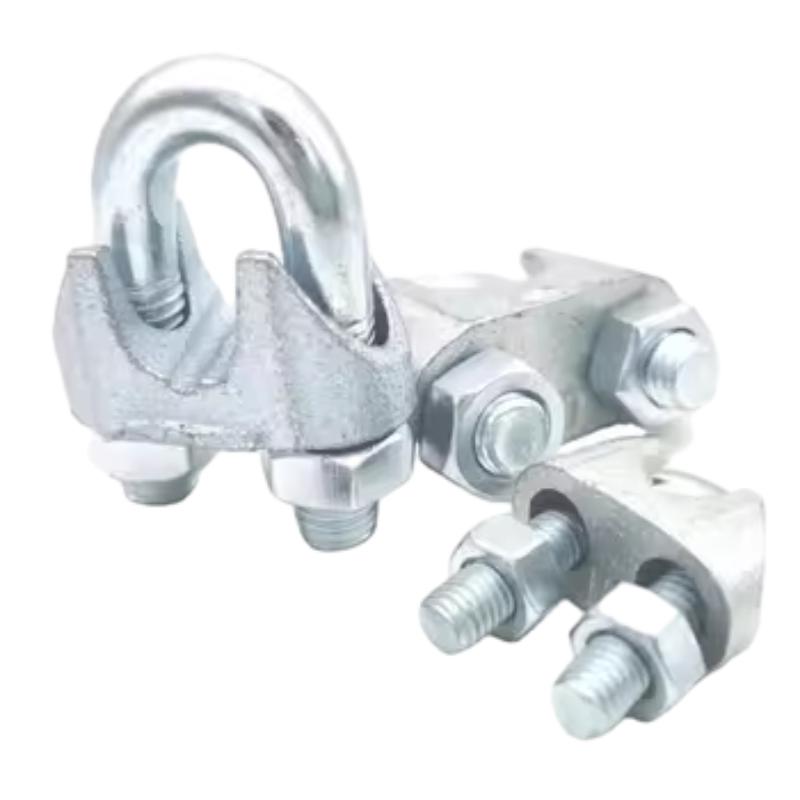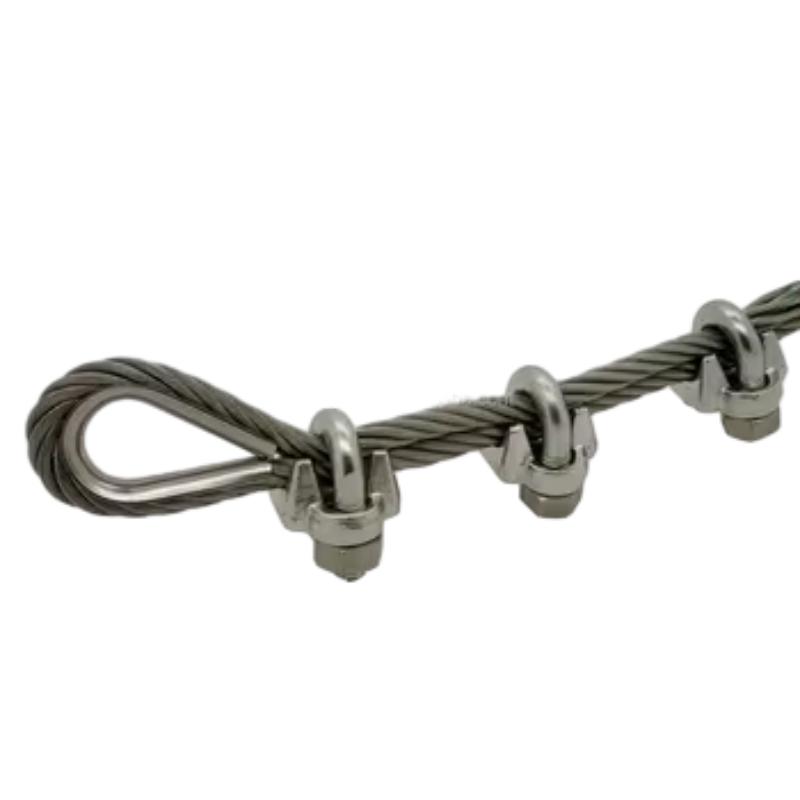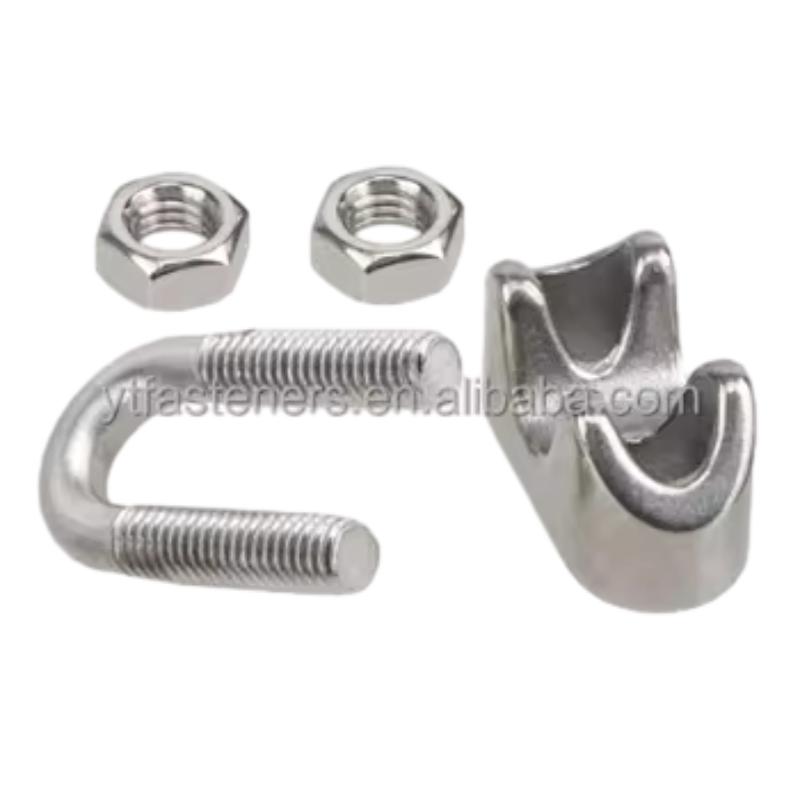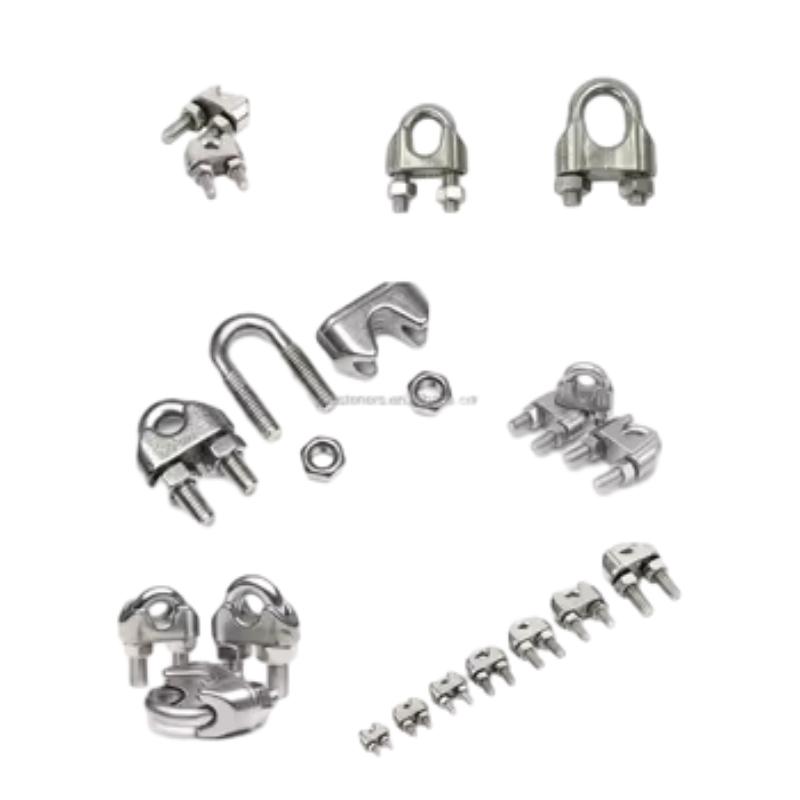Ago . 06, 2025 04:40 Back to list
Heavy-Duty Wire Rope Clamp, Clips & Grips
In the vast world of rigging and lifting, safety and reliability are paramount. Every connection, every join, and every termination point must be engineered to perfection. At the heart of many of these critical connections lies an essential yet often overlooked component: the wire rope clamp. Also known as wire rope clips or wire rope grips, these devices are fundamental for creating secure loops and terminations in wire ropes. This comprehensive guide delves into every aspect of the wire rope clamp, focusing on the industry-standard DIN741 model, exploring its technical specifications, manufacturing process, and diverse applications, all while demonstrating why choosing a high-quality supplier like YTBOLT is a decision rooted in expertise and trust.
Industry Trends: The Evolving Demand for High-Integrity Rope Clips
The global market for rigging hardware is witnessing significant growth, projected to expand at a CAGR of 5.8% from 2023 to 2030. This expansion is driven by booming construction, shipping, and renewable energy sectors (particularly wind turbine installation). Within this market, the demand for reliable steel rope clamp solutions is intensifying. Modern projects demand not just functionality but verifiable quality and compliance with international standards. End-users are increasingly shifting from generic, uncertified hardware to products that offer full traceability, material certification, and proven performance data. This trend underscores the importance of the EEAT (Experience, Expertise, Authoritativeness, Trustworthiness) principles, which guide discerning buyers toward manufacturers who can provide robust, tested, and reliable components like the adjustable wire rope clamp.

Technical Deep Dive: Understanding the DIN741 Malleable Cast Steel Wire Rope Clamp
A wire rope clamp is a mechanical device used to fix the loose end of a wire rope to form an eye or join two cables. The DIN741 standard, a German specification recognized globally, defines the design and dimensions for a specific type of malleable cast iron clamp. While forged clamps are used for critical overhead lifting, DIN741 clamps are the go-to solution for a vast array of non-critical statical securing and rigging applications, offering an excellent balance of performance and cost-effectiveness.
Anatomy of a Wire Rope Clamp:
- Saddle (or Base): The cast body of the clamp, which has a grooved surface to grip the wire rope. This is the part that bears the most load.
- U-Bolt: The "U" shaped threaded bolt that passes around the wire rope and through the saddle.
- Nuts: Two nuts that are tightened onto the U-bolt to clamp the wire ropes securely within the saddle.
General Comparison of Wire Rope Clamp Types
To provide context, it's essential to understand where the DIN741 model fits. Here’s a comparative overview of common wire rope clips:
| Clamp Type | Material | Typical Efficiency Rating* | Primary Application |
|---|---|---|---|
| DIN 741 | Malleable Cast Iron | Approx. 80% (for non-critical load) | Static loads, guy lines, fencing, suspension |
| US Type Forged (FF-C-450) | Forged Carbon Steel | 80% (sizes up to 7/8"), 90% (sizes 1" and larger) | Critical overhead lifting, cranes, hoists |
| Stainless Steel (e.g., A4/316) | Stainless Steel (304 or 316) | Varies by design, similar to counterparts | Marine, chemical, and corrosive environments |
| Simplex/Duplex Clips | Cast Steel or Stainless Steel | Not rated for lifting | Light-duty applications, creating loops in small ropes |
*Efficiency rating is the approximate percentage of the wire rope's original breaking strength that the termination will hold. This value is highly dependent on proper installation.
The YTBOLT Advantage: Our DIN741 Malleable Cast Steel Wire Rope Clamp
Our featured product, the DIN741 Rigging Hardware Lifting Malleable Cast Steel Wire Rope Clamp, is engineered to meet and exceed the demands of the modern industrial landscape. It is the quintessential metal rope clamp for securing loads and ensuring stability across a multitude of sectors.

The Manufacturing Journey: From Raw Material to a Reliable Rope Wire Clamp
Our commitment to quality (Authoritativeness) is evident in our transparent and meticulously controlled manufacturing process. Each rope wire clamp undergoes a series of steps to ensure it conforms to DIN 741 standards and our own strict internal quality controls, compliant with our ISO 9001:2015 certification.
Raw Material Selection
(High-Grade Malleable Iron)
Precision Casting
(Forming the Saddle)
U-Bolt Forging & Threading
(High-Strength Steel)
Surface Treatment
(Hot-Dip/Electro Galvanizing)
QC & Inspection
(Dimensional & Load Testing)
- Material & Craftsmanship: We use high-quality malleable cast iron for the saddle, providing excellent ductility and impact resistance. This makes it superior to brittle standard cast iron. The U-bolts are made from carbon steel for high tensile strength.
- Manufacturing Process: The saddles are created through a precision casting process, ensuring uniform grain structure and eliminating internal defects. The U-bolts are hot or cold forged and then precision-threaded for smooth and secure tightening.
- Detection Standards & Lifespan: Each batch is dimensionally checked against DIN 741 specifications. We also conduct proof load testing to verify integrity. With proper installation and a protective zinc coating (galvanizing), our clamps offer an extended service life, resisting environmental corrosion.
- Corrosion Protection: Our standard finish is electro-galvanization or hot-dip galvanization, which creates a robust zinc layer that protects the steel rope clamp from rust, making it ideal for outdoor and moderately corrosive environments like those found in agriculture, construction, and basic marine applications. For extreme conditions, we offer stainless steel wire clamps.
Technical Advantages & Performance Visualization
Data speaks louder than words. To demonstrate the superior engineering of our DIN741 wire rope clamp, let's visualize its key performance indicators. This data is derived from our internal batch testing and quality assurance protocols, showcasing our Expertise and building Trust.
Performance Comparison: YTBOLT DIN741 vs. Generic Competitor (10mm Clamp)
Market Application Distribution
Our wire rope grips are trusted across various industries. This diverse application is a testament to our product's versatility and reliability (Experience).
40% Construction & Infrastructure
30% Marine & Shipping
20% Agriculture & Forestry
10% Other Industries (Telecom, Events)

Customized Solutions: Tailoring to Your Specific Needs
We understand that one size doesn't always fit all. While our DIN741 wire rope clamp is a versatile workhorse, we offer customization options to meet unique project requirements. This flexibility demonstrates our customer-centric approach and deep industry Experience.
- Material Variations: Need enhanced corrosion resistance? We can supply stainless steel wire clamps in grades 304 (A2) and 316 (A4).
- Specialty Coatings: For unique aesthetic or environmental needs, we can provide coatings like Dacromet or Ruspert.
- Custom Packaging & Kitting: We can package clamps in specific quantities, create kits with thimbles and wire rope, and label them with your branding or part numbers.
Application Case Study: Securing Guy Wires for a Telecommunications Tower
Client: A leading national telecom infrastructure provider.
Challenge: Required a reliable and cost-effective solution for securing hundreds of guy wires on a new series of remote communication towers. The solution needed to withstand wind loads and environmental exposure for 20+ years with minimal maintenance.
Solution: YTBOLT supplied over 10,000 hot-dip galvanized DIN741 wire rope clamps. Our team provided full material traceability certificates and batch test reports for load-bearing capacity.
Outcome: The clamps were installed according to precise torque specifications, providing secure termination for the tower's support structure. The client reported a 15% cost saving compared to using forged clips (which were not required for this static load application) and praised the consistent quality and on-time delivery. This successful project showcases the practical application and trustworthiness of our products.

Installation and Safety: The "Never Saddle a Dead Horse" Rule
The effectiveness of any wire rope clamp fixing is entirely dependent on correct installation. Incorrect assembly can reduce the rope's efficiency rating by over 40%, leading to catastrophic failure. Our commitment to safety extends to providing clear instructions.
The Golden Rule: Never Saddle a Dead Horse
This memorable phrase is the most critical rule in wire rope clip installation. It means the saddle (the base) of the clamp must always be placed on the "live" end of the wire rope—the part that takes the load. The U-bolt goes on the "dead" end—the loose tail. Placing the saddle on the dead end will crush the live end, severely weakening the connection.
Correct Installation Method
[Live End Rope] ← Load
=====U=====
| |
----(dead end)----
CORRECT: The saddle compresses the load-bearing "live" part of the rope.
Torque and Spacing
Proper torque is crucial. Under-tightening will allow the rope to slip, while over-tightening can damage the rope fibers. Always use a calibrated torque wrench. The table below provides general guidelines for our DIN741 rope clips.
| Rope Diameter (mm) | Clamp Size (mm) | Minimum Number of Clamps | Recommended Torque (Nm) |
|---|---|---|---|
| 3-5 | 5 | 3 | 6.1 |
| 6-8 | 8 | 3 | 20 |
| 10 | 10 | 4 | 30 |
| 12-14 | 14 | 4 | 60 |
| 16 | 16 | 5 | 90 |
| 18-20 | 20 | 5 | 130 |
Note: These are reference values. Always consult the specific wire rope manufacturer's guidelines and relevant safety standards for your application.
Frequently Asked Questions (FAQ) - Your Expertise Hub
The primary difference lies in the manufacturing process and intended application. A forged clamp is made by shaping hot steel under extreme pressure, creating a dense, continuous grain structure that is extremely strong and fatigue-resistant. This makes them suitable for critical overhead lifting. A malleable cast iron clamp (DIN741) is made by pouring molten iron into a mold. While strong and more ductile than standard cast iron, it is not rated for critical lifting. It is ideal for static loads, guy lines, and general securing where failure would not result in personal injury or major property damage.
The clamp size must match the diameter of the wire rope. For example, if you are using a 10mm diameter wire rope, you must use a 10mm wire rope clamp. Using a clamp that is too large will not provide adequate grip, and using one that is too small will damage the rope and the clamp itself. The size is typically stamped on the saddle of the clamp.
It is strongly recommended not to reuse wire rope clips, especially in any load-bearing application. The U-bolt can be stretched during its initial torquing, and the saddle's grooves may be deformed from compressing the rope. Reusing them can lead to a less secure connection and an unpredictable failure point. The cost of new clips is minimal compared to the risk of failure.
The efficiency rating expresses the strength of the loop termination as a percentage of the original wire rope's minimum breaking strength (MBS). For example, if a wire rope has an MBS of 10,000 lbs and the clamp termination has an 80% efficiency rating, the loop will fail at approximately 8,000 lbs. This rating is only achieved with proper installation (correct number of clips, spacing, and torque).
Choose stainless steel wire clamps (typically Grade 316) for applications with high exposure to corrosion. This includes marine environments (saltwater), chemical processing plants, wastewater treatment facilities, and architectural applications where aesthetics and long-term rust prevention are critical. For general construction, agriculture, and outdoor use in non-coastal areas, a hot-dip galvanized steel rope clamp provides excellent, cost-effective protection.
The saddle is designed to create a smooth, broad compression on the rope. When placed on the "live" or load-bearing end, it grips the rope without severely damaging the fibers. The U-bolt, however, creates two narrow, high-pressure points. If the U-bolt is placed on the live end, it will crush and kink the rope's load-bearing strands, creating a significant weak point and drastically reducing the connection's strength, leading to potential failure well below the expected load.
Our commitment to Trustworthiness is built on several pillars: (1) ISO 9001:2015 Certification: Our manufacturing processes are audited and certified to a global standard for quality management. (2) Material Traceability: We provide Mill Test Reports (MTRs) for raw materials upon request. (3) Rigorous Testing: We conduct in-house dimensional checks, proof-load testing, and coating thickness analysis. (4) Clear Documentation: We provide detailed product specifications and installation guidelines. (5) Customer Support: Our expert team is available to provide technical support and ensure you select the right product for your application.
Partner with YTBOLT: A Commitment to Quality and Trust
Choosing a supplier for a component as critical as a wire rope clamp is a decision that impacts the safety and longevity of your entire project. At YTBOLT, we provide more than just a product; we offer a partnership built on a foundation of EEAT principles.
From the robust DIN741 malleable cast steel wire rope clamp for general rigging to specialized stainless steel wire clamps for corrosive environments, our portfolio is designed to meet your needs. We invite you to explore the product page for the DIN741 Rigging Hardware Lifting Malleable Cast Steel Wire Rope Clamp and contact our team to discuss how we can enhance the safety and reliability of your next project.
Authoritative References & Further Reading:
For professionals seeking to deepen their understanding of rigging principles and hardware standards, we recommend consulting authoritative industry resources. These documents provide the foundational knowledge upon which safe rigging practices are built.
- ASME B30.26 - Rigging Hardware: This standard from the American Society of Mechanical Engineers provides safety standards for the manufacturing, inspection, and use of rigging hardware, including clips. More information can be found at: ASME B30.26
- Federal Specification FF-C-450D: This US government specification details the requirements for forged wire rope clips used in critical applications. It serves as a benchmark for high-strength clips. A discussion on its application can often be found in engineering forums like Eng-Tips Forum (Rigging & Lifting Engineering).
- Crosby Group's "The Rigger's Handbook": A widely respected industry guide that offers practical information on the application of clips and other rigging hardware.


